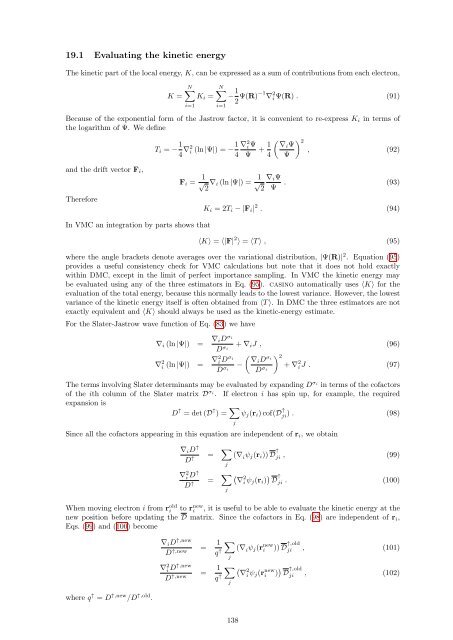CASINO manual - Theory of Condensed Matter
CASINO manual - Theory of Condensed Matter
CASINO manual - Theory of Condensed Matter
You also want an ePaper? Increase the reach of your titles
YUMPU automatically turns print PDFs into web optimized ePapers that Google loves.
19.1 Evaluating the kinetic energy<br />
The kinetic part <strong>of</strong> the local energy, K, can be expressed as a sum <strong>of</strong> contributions from each electron,<br />
N∑ N∑<br />
K = K i = − 1 2 Ψ(R)−1 ∇ 2 i Ψ(R) . (91)<br />
i=1<br />
i=1<br />
Because <strong>of</strong> the exponential form <strong>of</strong> the Jastrow factor, it is convenient to re-express K i in terms <strong>of</strong><br />
the logarithm <strong>of</strong> Ψ. We define<br />
T i = − 1 4 ∇2 i (ln |Ψ|) = − 1 ∇ 2 i Ψ<br />
4 Ψ + 1 4<br />
( ) 2 ∇i Ψ<br />
, (92)<br />
Ψ<br />
and the drift vector F i ,<br />
Therefore<br />
F i = 1 √<br />
2<br />
∇ i (ln |Ψ|) = 1 √<br />
2<br />
∇ i Ψ<br />
Ψ . (93)<br />
K i = 2T i − |F i | 2 . (94)<br />
In VMC an integration by parts shows that<br />
〈K〉 = 〈|F| 2 〉 = 〈T 〉 , (95)<br />
where the angle brackets denote averages over the variational distribution, |Ψ(R)| 2 . Equation (95)<br />
provides a useful consistency check for VMC calculations but note that it does not hold exactly<br />
within DMC, except in the limit <strong>of</strong> perfect importance sampling. In VMC the kinetic energy may<br />
be evaluated using any <strong>of</strong> the three estimators in Eq. (95). casino automatically uses 〈K〉 for the<br />
evaluation <strong>of</strong> the total energy, because this normally leads to the lowest variance. However, the lowest<br />
variance <strong>of</strong> the kinetic energy itself is <strong>of</strong>ten obtained from 〈T 〉. In DMC the three estimators are not<br />
exactly equivalent and 〈K〉 should always be used as the kinetic-energy estimate.<br />
For the Slater-Jastrow wave function <strong>of</strong> Eq. (83) we have<br />
∇ i (ln |Ψ|) = ∇ iD σi<br />
+ ∇ i J , (96)<br />
D σi ( ) 2<br />
∇ 2 i (ln |Ψ|) = ∇2 i Dσi ∇i D σi<br />
−<br />
+ ∇ 2<br />
D σi D σi i J . (97)<br />
The terms involving Slater determinants may be evaluated by expanding D σi in terms <strong>of</strong> the c<strong>of</strong>actors<br />
<strong>of</strong> the ith column <strong>of</strong> the Slater matrix D σi . If electron i has spin up, for example, the required<br />
expansion is<br />
D ↑ = det (D ↑ ) = ∑ ψ j (r i ) c<strong>of</strong>(D ↑ ji ) . (98)<br />
j<br />
Since all the c<strong>of</strong>actors appearing in this equation are independent <strong>of</strong> r i , we obtain<br />
∇ i D ↑<br />
D ↑ = ∑ j<br />
∇ 2 i D↑<br />
D ↑ = ∑ j<br />
(∇ i ψ j (r i )) D ↑ ji , (99)<br />
(<br />
∇<br />
2<br />
i ψ j (r i ) ) D ↑ ji . (100)<br />
When moving electron i from r old<br />
i<br />
to r new<br />
i , it is useful to be able to evaluate the kinetic energy at the<br />
new position before updating the D matrix. Since the c<strong>of</strong>actors in Eq. (98) are independent <strong>of</strong> r i ,<br />
Eqs. (99) and (100) become<br />
where q ↑ = D ↑,new /D ↑,old .<br />
∇ i D ↑,new<br />
D ↑,new = 1 ∑<br />
q ↑ (∇ i ψ j (r new<br />
i )) D ↑,old<br />
ji , (101)<br />
j<br />
∇ 2 i D↑,new<br />
D ↑,new = 1 ∑ (<br />
∇<br />
2<br />
q ↑ i ψ j (r new<br />
i ) ) D ↑,old<br />
ji , (102)<br />
j<br />
138

















